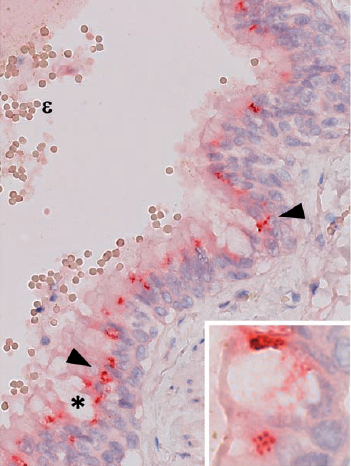Virus de la influenza
Resumen
El virus de la influenza es un importante agente patógeno humano que causa infecciones respira-torias y una considerable morbimortalidad anual a nivel mundial. El virus puede circular esporádicamente durante brotes locales como parte de una epidemia estacional o puede generar una pandemia mundial.Descargas
Referencias bibliográficas
Schnitzler SU, Schnitzler P. An update on swine-origin influenza virus A/H1N1: A review. Virus Genes. 2009;39:279-92. http://dx.doi.org/10.1007/s11262-009-0404-8
Taubenberger J, Morens D. The pathology of influenza virus infections. Annu Rev Pathol. 2008;3:499-522. http://dx.doi.org/10.1146/annurev.pathmechdis.3.121806.154316
World Health Organization. Influenza (seasonal). Fact sheet N° 211, March, 2014. Fecha de consulta: 14 de octubre de 2015. Disponible en: http://www.who.int/mediacentre/factsheets/fs211/en.
Barker W, Mullooly J. Pneumonia and influenza deaths during epidemics: Implications for prevention. Arch Intern Med. 1982;142:85-9. http://dx.doi.org/10.1001/archinte.1982.00340140087016
Michaelis M, Doerr HW, Cinatl J Jr. An influenza A H1N1 virus revival - pandemic H1N1/09 virus. Infection. 2009;37: 381-9. http://dx.doi.org/10.1007/s15010-009-9181-5
Sullivan SJ, Jacobson RM, Dowdle WR, Poland GA. 2009 H1N1 influenza. Mayo Clin Proc. 2010;85:64-76. http://dx.doi.org/10.4065/mcp.2009.0588
Craighead J. Influenza viruses. En: Craighead J, editor. Pathology and pathogenesis of human viral disease. First edition. St. Louis: Academic Press; 2000. p. 35-46.
Instituto Nacional de Salud. Semana epidemiológica número 18 de 2010. Boletín Epidemiológico Semanal del 2 al 8 de mayo de 2010. Bogotá, D.C.: INS; 2010.
Hinrichs S, Harrison C, Haggerty S. Viral diseases. En: Damjanov I, Linder J, editors. Anderson´s pathology. Tenth edition. St. Louis: Mosby Yearbook Inc.; 1996. p. 922-3.
Nicholson K, Wood J, Zambon M. Influenza. Lancet. 2003; 362:1733-45. http://dx.doi.org/10.1016/S0140-6736(03)14854-4
Teichtahl H, Buckmaster N, Pertnikovs E. The incidence of respiratory tract infection in adults requiring hospitalization for asthma. Chest. 1997;112:591-6. http://dx. doi.org/10.1378/chest.112.3.591
Mäkelä MJ, Nikkari S, Meurman O, Laine M, Arvilommi H. Virus-specific, antibody-secreting cells during upper respiratory infections. J Med Virol. 1995;47:416-20.
Guarner J, Shieh W, Dawson J, Subbarao K, Shaw M, Ferebee T, et al . Immunohistochemical and in situ hybridization studies of influenza A virus infection in human lungs. Am J Clin Pathol. 2000;114:227-33. http://dx.doi.org/10.1309/HV74-N24T-2K2C-3E8Q
Cheon S, Chae C, Lee Y. Detection of nucleic acids of porcine reproductive and respiratory syndrome virus in the lungs of naturally infected piglets as determined by in-situ hybridization. J Comp Pathol. 1997;117:157-63.
World Health Organization. CDC protocol of real time RT-PCR for influenza H1N1. Geneva: WHO Fecha de consulta: 19 de noviembre de 2015. Disponible en: http://www.who.int/csr/resources/publications/swineflu/realtimeptpcr/en/.
Haines D, Waters E, Clark E. Immunohistochemical detection of swine influenza virus in formalin-fixed and paraffin-embedded tissues. Can J Vet Res. 1993;57:33-6.
Vincent L, Janke B, Paul P, Halbur P. A monoclonal antibody�based immunohistochemical method for the detection of swine influenza virus in formalin-fixed, paraffin-embedded tissues. Vet Diagn Invest.1997;9:191-5. http://dx.doi.org/10.1177/104063879700900214
Guarner J, Paddock C, Shieh W, Packard M, Patel M, Montague J, et al . Histopathologic and immunohisto-chemical features of fatal influenza virus infection in children during the 2003-2004 season. Clin Infect Dis. 2006;43:132-40. http://dx.doi.org/10.1086/505122
Rogers G, Paulson J. Receptor determinants of human and animal influenza virus isolates: Differences in receptor specificity of the H3 hemagglutinin based on species of origin. Virology. 1983;127:361-73.
Gagneux P, Cheriyan M, Hurtado-Ziola N, van der Linden E, Anderson D, McClure H, et al . Human-specific regulation of alpha 2-6-linked sialic acids. J Biol Chem. 2003;278: 48245-50. http://dx.doi.org/10.1074/jbc.M309813200
Nelli R, Kuchipudi S, White G, Pérez B, Dunham S, Chang K. Comparative distribution of human and avian type sialic acid influenza receptors in the pig. BMC Vet Res. 2010;6:4. http://dx.doi.org/10.1186/1746-6148-6-4

| Estadísticas de artículo | |
|---|---|
| Vistas de resúmenes | |
| Vistas de PDF | |
| Descargas de PDF | |
| Vistas de HTML | |
| Otras vistas | |

























